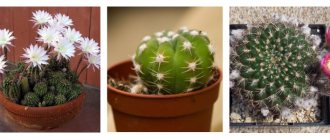Cactus care
Succulent crops are fairly unpretentious plants, loved by many for their extraordinary appearance. However, they also have some peculiarities in cultivation, in particular in the question of how to water cacti growing at home. There are a lot of nuances that predetermine not only the beauty of a prickly plant, but also influence its preservation of its aesthetic appearance and even its existence, in principle, as a houseplant. We will answer important questions regarding hydration of cacti.
- 1 How often should cacti be watered at home? 1.1 What water should I use for irrigation?
- 1.2 How many days after transplantation can a cactus be watered?
- 1.3 How and when should small cacti be watered?
Features and rules for watering cactus
Regardless of the purpose for which you bought a cactus - growing a large number, decorating a windowsill with a couple of flowerpots, or as a gift to a loved one - you need to remember the rules of care and watering. It is a competent strategy and systematic approach that will ensure active growth, flowering and the appearance of new shoots for further replanting.
Cacti on the windowsill
It is necessary to be especially careful when watering succulents of flowering varieties, since a lack or excess of moisture can negatively affect the timely appearance of a healthy bud.
When choosing succulents as a home plant, you should not take them lightly and turn a blind eye to the rules of watering. Using the wrong water, excess fertilizer or incorrect watering techniques can cause the plant to die in a short time.
Light for cacti in the house
The homeland of almost all varieties and types of cacti is the desert, which means our plants need a lot of sunlight. Most of them should be illuminated for at least 8 hours a day. So, we place pots with cacti on light windowsills or use a phyto lamp to illuminate them.
And in spring and summer, you can safely take them outside in warm sunny weather so that they get a real sunbath. It is better to return some varieties to the house overnight, but there are some that tolerate cool weather well.
How often to water
The frequency of watering a home cactus directly depends on many factors. The most important of them are described below.
Plant type
Astrophytum cactus: options for different types and examples of care at home
The seller must tell you about this and also provide instructions for caring for a specific variety. For example, if the future pet was brought from the desert, it will not be too whimsical and water-loving. Such plants need minimal irrigation once a week or a week and a half, and even then only in the hot summer.
Important! Succulents brought from the tropics love high humidity, so they need more frequent watering in both winter and summer.
There is nothing simpler than instructions on how to water Decembrist or prickly pear - they are not afraid of water in any quantity. Mammillaria is the same unpretentious plant.
Succulent placement
If you place a plant at home on a window located on the sunny side, or next to a powerful battery, heater, computer or laptop ventilation, it will require more moisture. In cooler and less lit areas, water less often and less frequently.
Pot material
Even such a minor detail affects the frequency. Ceramic and clay pots slightly promote moisture absorption, so more frequent and intense watering will be needed. There are much fewer problems with plastic and glass dishes.
Age of cactus
If the plant is very young, it spends more nutrients from water and substrate for its development and flowering. Therefore, it needs more moisture than its older brothers.
Different types of cactus need different frequency of watering
Life cycle
When the plant begins its growing season, that is, it actively begins to grow, and the ovary appears in flowering varieties, you need to prepare for frequent watering. This is usually the period from late spring to late autumn.
Due to the relocation of a succulent to a different environment, its natural cycle may be disrupted, and the growing season begins in winter. The change in behavior must be carefully monitored so as not to leave the plant without moisture, which is vital at this time.
Substrate condition
This is a separate and very important issue when growing a healthy and strong cactus, since most of the so-called universal store-bought substrates actually contain a lot of components that are dangerous to the plant. Sometimes the quality of the soil simply leaves much to be desired: a solid mass of peat does not deliver water to the roots, and a lot of loose sand or clay, on the contrary, leads to their rotting.
Attention! Watering the cactus and its frequency also depends on the quality of the water and the additives in it. It may be necessary to observe the moisture absorption and condition of the succulent for some time to determine the optimal frequency.
Hydration rules
There are certain rules for watering a cactus in order to provide the plant with moisture in a timely manner. They impose requirements not only on the frequency of irrigation, but also on the quality of water:
- Preference should be given to rare but abundant watering rather than frequent and little by little.
- The water should be soft, preferably distilled. If it is extremely hard, it must be boiled.
- It is important to ensure that there are no impurities in the water.
- It is advisable to have drainage at the bottom of the pot to avoid stagnation of moisture.
- The next day after moistening, it is necessary to loosen the substrate.
- Water for irrigation should not be cold, at least 15 degrees Celsius.
- If the summer turns out to be cold, and the temperature of the room where the plant is located does not rise above 10 degrees, watering should be postponed until it warms up. Otherwise, you can cause the plant to rot, followed by death.
In summer, cacti can be taken outside, providing them with shade and protection from rain. In hot and dry air, irrigation can be carried out daily. How often to water a cactus that is outdoors in summer depends on the condition of the substrate, which must be checked periodically.
What water to water a cactus
Ideally clean water in the modern world, especially in megacities, is a legend. Most houseplants adapt over time and respond well to regular tap water. But succulents, due to the characteristics of their origin, react painfully to poor chemical composition of water. How can you improve performance and make the watering process easier?
How to water aloe: frequency and options at home
The best way is to use collected rain or melt water. But this option requires too much effort and patience, so it is not suitable for everyone. A simpler idea is to boil and cool water to reduce its hardness and pH level. This way you can avoid alkalization of the soil and the negative effect of water on the root system when watering cacti.
Note! If you don’t have any time to manipulate water, you can use regular household filters or fill a container and let it sit for 2-3 days before watering.
To improve the quality of water and fertilizing, you can use the following means:
- oxalic or nitric acid (don’t forget to let it settle and drain off the sediment);
- succinic acid (only a one percent solution is suitable);
- diluted peat;
- vinegar 9% (no more than a teaspoon per five-liter container).
What water is suitable for irrigation?
Like most indoor flowers, cacti prefer soft water without chlorine or mineral salts. It is advisable to use settled or filtered liquid. If it is hard and leaves a white residue when boiled, then you can balance the acidity by adding a few drops of lemon juice or half a teaspoon of table vinegar per liter of H2O. It is also better to leave the melt or rain water so that excess impurities settle to the bottom and do not harm the plants.
20130718145203.jpg
The water temperature for watering succulents should not be lower than +20...25 °C in summer and +35...40°C in winter. If you neglect this rule, the plants will become overcooled and get sick. Such an omission will quickly affect the appearance of exotic pets - they will begin to darken and rot in the lower part of the stem.
5bd8e2e033c3a5bd8e2e036433.jpg
Water temperature
How to replant a cactus: options at home
Everything here is relatively simple: under no circumstances should you water succulents with cold water. It should be room temperature, and ideally a little warmer than the air temperature. Cold and excess moisture are the two main enemies of your plant; cacti get sick and die from them.
In healthy cacti, the soil is always slightly dry
Kinds
Ficus fertilization is carried out with both organic and mineral products.
- waste products of birds and domestic animals;
- vegetable compost mixtures.
Mineral supplements mean chemical compounds:
- rock minerals;
- salt;
- industrial waste.
Application frequency
Ficus feeding is carried out infrequently
They should be plentiful, this is especially important for mature plants that have an extensive leafy crown
Large ficus plants greatly deplete the soil in the pot. To eliminate this problem, you need to add nutrients.
The mode and rate of fertilizer application depends on the time of year:
- In summer and spring the interval is 10-14 days.
- In winter, ficus is not fertilized.
Methods of application
The plant is fed by root and non-root methods.
- The first contributes to the normal development of the root system.
- Foliar foliar helps strengthen the plant’s immunity and protect it from the development of diseases.
- Foliar feeding can be carried out by “dusting” the plant. This procedure helps get rid of pests and diseases.
- The second option for foliar fertilizer is exposure through the soil. In this way, you need to apply drugs during the period of active growth - from spring to mid-autumn. The nutrient mixture is applied to moist soil.
Specifics of watering depending on the season
Although the life cycle of a succulent is the most important indicator, different seasons require different strategies.
in autumn
Plants usually end their growing season and are preparing for “hibernation.” The amount of moisture must be reduced and the frequency of watering reduced to a minimum - once a month will be enough.
in winter
Succulents really go into a dormant state: they need to be placed in a cool, dark place and watering reduced to a minimum. If in the fall the frequency of watering the cactus was once a month, then in winter once or twice for the entire season will be enough.
Important! Do not be alarmed if your pet shrinks slightly - this is normal behavior and is not at all a sign that something was done incorrectly.
in spring
Spring awakening is quite slow, so plants completely return to their previous state by mid-to-late April. The main sign that the plant is entering the growing season is the appearance of new needles at the top and fresh greenery.
First you only need to lightly moisten the substrate, preferably with hot water. This will help the plant wake up faster. If the weather is sunny and the plant is “active,” you need to continue to water it gradually in the morning after the soil has completely dried. Then gradually increase the frequency of watering to once every 7-10 days.
Important! In the summer, watering the cactus should be more frequent, especially if it is in the sun. But on rainy days and high humidity there is no need to water - the plant will take everything from the air.
Fertilizing cactus
There are many different points of view regarding feeding cacti with fertilizers. This is a rather controversial issue and, as a rule, it is based on someone else's experience. Since cacti are very unique plants, fertilizers are special for them. First of all, they differ in that they contain much less nitrogen.
In cacti, the need for nitrogen is extremely limited due to certain physiological characteristics. If there is a lot of nitrogen in the soil, or a lot of nitrogen is in the applied fertilizer, then the cactus stem begins to grow quickly, becomes loose and watery. Many children and offspring appear, but they do not develop into full-fledged plants; the skin of the cactus does not have time to grow and bursts. Wounds and scars appear that rot or become crusty, and as a result the plant will be disfigured or die. Therefore, organic fertilizers are not used for cacti, except in very small doses for epiphytic, fast-growing cacti.
Cacti need phosphorus and calcium more; plants also need potassium during flowering. It is best to use special fertilizers for fertilizing cacti, which are now on sale almost everywhere.
These include “Cactus”
– special concentrated liquid
humic fertilizer
, contains auxins, cytokinins, vitamins B, C, humic acids, nitrogen, phosphorus, potassium. Promotes growth, rooting, flowering, increases resistance to disease. Available in 0.5 liter bottles. Forest cacti - during the period of budding and flowering, 2 caps (8-10 ml) of fertilizer are diluted in 1 liter of water and watered after each watering. Desert cacti - 1 cap per 2 liters of water - water once every two weeks from March to October. Do not use during rest period. Feeding begins no earlier than two weeks after transplantation.
This is important: Since flowering in cacti does not always coincide with the growth period, do not feed your cacti with anything during flowering in winter. You can start feeding cacti only with the onset of the growth period - late March, early April. Fertilizing should be completed before the dormant period begins, i.e. in September. Winter-blooming cacti do not require additional feeding, since the plant itself does not grow, so watering is only slightly increased.
Ways to water a cactus
Having found out the dependence of the frequency of watering a cactus on the weather, its origin, location and other factors, it is worth understanding the technical nuances of the issue.
You can't water like that
Watering from above
Do not pour water on top of the pot, capturing the stem and flower of the succulent. Water to the plant should come from the root, and the stem can only be lightly sprayed from the smallest diffuser if a lot of dust, sand or cobwebs have collected on it.
You can water the cactus from above, but the main task is to protect the stem from excess droplets. You will need a small water container with a narrow neck to allow you to control the water flow. When top-irrigating, you should try to give so much water that the entire lump of substrate in the pot is immediately saturated, and the water reaches the roots.
Important! Irrigating the plant gradually and in small portions from above is not recommended, because it is much easier to overwater the plant and create unfavorable conditions for it.
Watering tray
This option requires a little more preparation, but is more advantageous:
- Water is guaranteed not to get on the stem and will not harm the development and growth of the succulent.
- The short root system of the cactus will receive better and faster nutrition.
- Minerals from additives and substrate will be washed out much more, providing the plant with a favorable environment for development, reproduction and flowering.
Cacti in an individual tray
For watering through a tray, it is recommended to choose low plastic pots with holes at the bottom. It is better to buy a tray with high edges so that water does not spread over the table and windowsill. In addition, depending on the size, the tray can provide moisture for either one plant or a large collection of cacti. The main thing is not to forget that some succulents may need additional feeding or, conversely, less liquid, so it is better to place them separately.
When watering through a tray, it is most difficult to track how much moisture gets into each pot, so if the cacti are capricious and need a separate irrigation regime, it is better not to experiment. If it is difficult to determine how wet the soil is, it makes sense to buy a special device for measuring moisture and adjust the soil moisture plan according to its indicators.
Important! 20-30 minutes after watering, it is necessary to remove excess water from the pan to avoid excessive moisture in the roots of the succulent.
When replanting a plant, you need to moisten the soil after transferring it to another container and leave it for a while, observing the condition. Succulents experience some stress, so they may consume less liquid.
Transplanting a plant
The cactus is replanted in the spring. Only young plants are replanted annually. Those who have reached 4 years – after 2 or 3 years. Dishes for replanting cacti can be of any shape. But cube flowerpots made of white polystyrene have become popular for growing cacti. If they have a retractable bottom, then removing the cactus from such a pot is much easier.
The size of the pot is slightly larger than the diameter of the cactus. A layer of gravel is placed at the bottom, which will allow moisture to easily pass through the soil. The base of the cactus should be positioned at the same level as the pot. Spread the roots in different directions. Sprinkle with mixture. It is advisable to place a layer of sand or gravel on top. It will protect the soil from compaction and drying out. You can choose beautiful decorative stones that will decorate the pot.
After replanting, the cactus is not watered for 4 days, but exposed to the sun after it has taken root.
The soil mixture consists of washed river sand, finely broken brick, peat, turf and leaf soil. They make the composition loose and breathable. Peat is taken 2 times less than sand. It will help make the soil slightly acidic. The prepared soil is steamed to disinfect it.
Mixtures for young and adult cacti differ in composition. For young people you need to add turf soil, for adults - clay. You can buy a ready-made mixture at a flower shop. Cacti that grow quickly need humus. For spiny species, eggshells are added to the soil.
Watering options at home
Being fairly unpretentious plants, cacti do not require complex care. For a comfortable process, you can purchase or make your own neat irrigation system that will provide the soil with the necessary amount of moisture.
Healthy and beautiful cacti with proper care
You will need a small plastic bottle, which should be placed above the plant, and a small tube - medical for droppers or a regular cocktail tube. You need to make a hole in the bottle cap with an awl and insert the tube there. Such a simple device will protect the flowers and stem of the cactus from excess moisture, and the roots will receive the required amount of water.
Important! For plants accustomed to a dry environment, this method of watering is not suitable.
It is quite possible that when choosing a method for watering a cactus, you will have to spend a lot of time and conduct more than one experiment. But by choosing one guaranteed suitable method, you can save yourself a lot of hassle.
When watering a cactus, the main thing to remember is that it does not like frequent irrigation and needs significantly less liquid than other plants. The watering plan should correspond to the variety of succulent, its life cycle and season.
Do not flood the roots and water the plant frequently during hibernation. It is worth taking care of high-quality water and carefully monitoring the condition of your green pet. Following these simple rules will allow the cactus to grow healthy and please its owner for many years.
Selecting container and soil
Selection of container:
Cacti are quite demanding on the container in which they will grow. The size of the pot should match the root system of the cactus. To choose the right pot , you need to remove the cactus from the old container, carefully straighten the roots and inspect the root system. In some cacti, the roots are better developed in the upper part and are not very long, then the pot should be wide enough, but not deep. In other cacti, the roots grow in length, especially if the root system has a main taproot, then the pot should be deep , but not wide. In any case, the volume of a pot or other container for planting should not greatly exceed the volume of the root system in a straightened form, but it must be taken into account that some space in the pot will be taken up by drainage.
brown spots have appeared on it , or has been damaged in some way, then the dishes should be slightly smaller in size than the volume of the root system. Also, when choosing a container, you should take into account the growth pattern of cacti. For example, mammillaria form many children and many plants are obtained in one pot, so they need wider pots, but not deep ones (see picture). But for Ariocarpus, for example, the container should be deeper than wide.
What material the container for growing a cactus is a matter of taste. Cacti are usually grown in plastic pots, but they can also be grown in clay pots, plastic yogurt cups, ceramic cups, coconut shells, etc. It is undesirable to grow cacti only in metal containers, which can rust, and this will adversely affect the plant.
If there are a lot of cacti and the collection is growing, then it is quite convenient to plant the cacti in square or rectangular containers, which are then placed easily and tightly together on a common tray; this makes it easier to carry the cacti; the tightly arranged pots occupy a stable position. the frequency of watering depends on what material the container is made of . In plastic dishes, the earth retains moisture longer than in clay ones.
Another condition for containers for cacti is drainage holes. I would say that this is a mandatory condition, since cacti really do not like stagnant water in a pot (especially epiphytes). Water that remains in the roots can lead to rotting and death of the plant.
The soil:
Preparing soil for replanting cacti is a complex and controversial issue, in the sense that the composition of the soil depends on many factors, for example, the type of cactus, its age, etc. Different literature provides different recipes and methods for preparing soil for cacti. Despite the fact that they sometimes differ, each author who recommends one or another soil recipe, as a rule, relies on his own experience, which has had good results. The ingredients included in traditional cactus soils are varied, but always the same, these are:
| Ingredients | Properties | Where to get them |
| Leaf ground | rich in nutrients, loose, light, easily absorbs water | In the spring (April), when the snow is just melting in any birch grove or park where there are deciduous trees, the snow, old leaves are raked and the earth is collected with a scoop |
| Clay-turf soil | holds water firmly, and nutrients are washed out of it more slowly | Near the garden, where the ground is overgrown with turf (dense grass), this turf is removed along with the soil with a shovel and laid in layers that can be shed with slurry, then covered and left for at least one year. If this technology is difficult for you, then you can get this soil differently. You need to dig up the turf and, holding the grass, thoroughly shake off the soil from its roots. In this case, it will not be as nutritious as if it had been pressed for a year, but the structure will meet the requirements. |
| Old greenhouse land | used when it is not possible to obtain leafy and clay-turf soil | In the vegetable garden |
| Well-rotted manure (humus) | used in limited quantities to add to very nutrient-poor soil | In the spring, cow manure in the garden or vegetable garden is placed in a tank or compost pit and covered with leaves (birch or apple) and soil, then dug up and used the next spring. |
| Coarse river sand | gives the soil looseness and porosity, is an essential component in any soil for all cacti | On the river, on the beach, be sure to wash well |
| Charcoal | (only deciduous trees), used for disinfection in powder form (sprinkled on wounded roots) and added in pieces to the soil, because has anti-putrefactive properties | Burn any stick made of deciduous trees in the garden or vacant lot, preferably birch, break the firebrand into pieces. Crush some into powder, and leave some in small pieces and add to the soil. |
| Brick chips | Gives the soil looseness and porosity, has the ability to retain excess moisture | Use a hammer to crush red bricks into crumbs, which can be found wandering around the city or at the nearest construction site |
Before choosing a particular soil mixture, you need to know that in any case, it must meet the following requirements:
- the soil for any cacti should be loose, easily allow water and air to pass through,
- The acidity of the soil for almost all cacti should be slightly acidic, better than pH = 4.5 - 6.
You need to know that leaf soil is looser than clay-turf and greenhouse soil. Brick chips and river sand give the soil looseness. And to give the soil the necessary acidity, add either peat (to increase acidity) or lime (gives an alkaline reaction and reduces acidity). It should be borne in mind that young cacti and prickly seedlings need looser and more nutritious soil, so leaf soil makes up a significant proportion of the soil mixture for them.
Adult and old cacti need denser soil, so they take more greenhouse and clay-turf soil. For fast-growing cacti, humus is added to the soil mixture. What else will the composition of the soil mixture depend on? Depending on the species characteristics of the plant, for example, cacti that have absolutely no spines need less calcium in the soil than cacti richly decorated with spines, which benefit from adding crushed, crushed eggshells to the soil.
Recommendations on how to properly replant a cactus
If the transplanted cacti do not have obvious damage and no root pruning has been done, their root systems can not be dried out, but can be immediately replanted in fresh soil. You just need to make sure that the soil is in proper condition. Transplanted cacti are kept in a warm, bright place, but not in the sun.
Many cacti require larger pots when transplanting. In principle, a large pot is always preferable. The main obstacle to this is the limited window sill area allocated for the collection, so you have to look for a reasonable compromise. When replanting, sometimes you have to take into account not only the size of the roots, but also the size of the stem. Some species with large stems have relatively weak and small roots. Large taproots should not touch the bottom of the pot. This leads to the growth of the cactus stopping and the roots rotting. For some species with large taproots, the pots have to be significantly increased in height.











